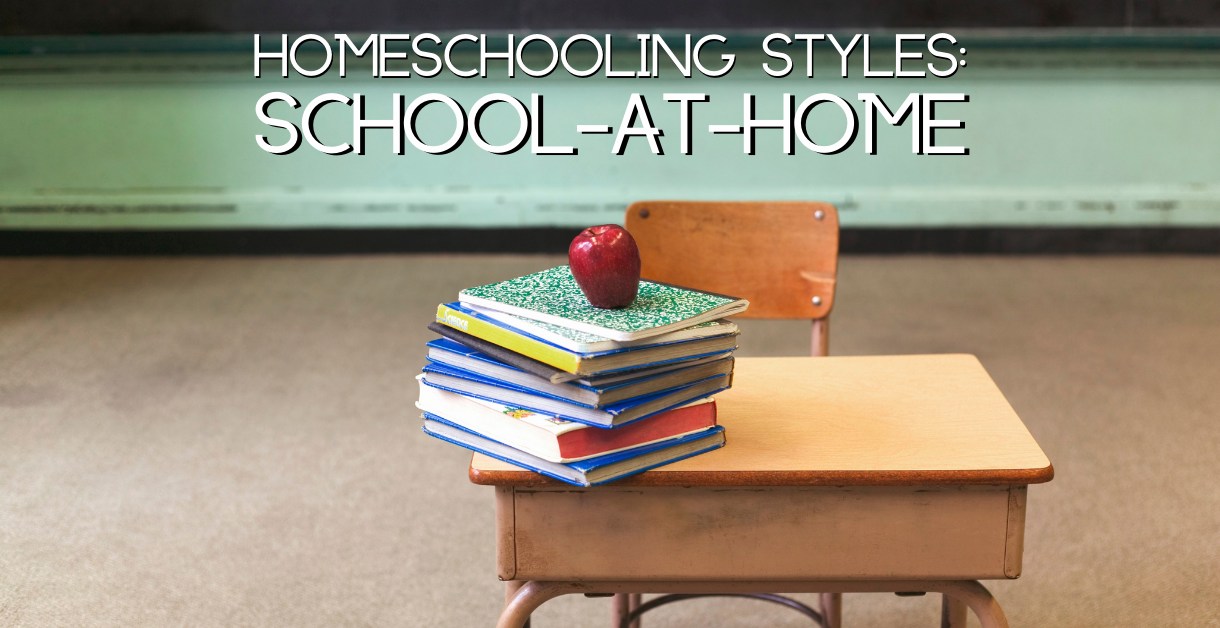Like many other new homeschool families, when we began homeschooling our children, we attempted the School-at-Home (also known as Traditional Homeschooling) methodology. What exactly is the School-at-Home method? As the name implies, School-at-Home is basically recreating the public or private school classroom in your home. This method typically uses a complete curriculum package that includes the student textbook, teacher manuals, workbooks, tests and other necessary tools to be able to teach the student for an entire year. Alternatively, some families enroll in an online "distance learning" program in which all courses are standards aligned similar to those used in public and private schools.
Some reasons this method is chosen:
Familiarity with the teaching method – When we have had no previous experience with homeschooling, it is comforting to begin with what we have learned from our own education background. By implementing what we know, we can become more confident in our choice to homeschool.
Homeschooling short term – Sometimes circumstances arise where a student is unable to attend public or private school for a short period of time but they still want to be sure that they remain on the same academic track they were on, making the transition back into public or private schools less complicated with little to no learning gaps.
"Proof" of learning progress – Some parents may be uncomfortable with or unsure of how to measure their student's academic progress as well as feel the pressure of being able to prove progress to others. Most school-at-home curriculum include an easy and tangible method of measuring and recording results and benchmark learning typically match those of state standards.
Little lesson planning or curriculum shopping needed – Curriculum needed to school-at-home typically come in grade-level, ready-to-use bundles that include all books, workbooks, materials, and lesson plans needed to implement a full year of classes. Having lessons plans pre-made takes the guesswork out of what to do next.
Prefer structured and scheduled coursework with teacher-led instruction – Some students excel in a systematic learning environment with a predictable school time routine as well as having a teacher providing all necessary guidance through courses.
Some reasons this method may not be for you:
Can be expensive – Although there are some free and low-cost school-at-home resources available, typically all-in-one curriculum is more costly because the curriculum is often sold in bundles and meant for only one school year and, if following the same course materials as your local public or private school, textbooks may be different from year-to-year. And even if they stay the same, textbooks and teacher manuals may be recycled for additional children, but more often than not you will still need to purchase new consumables. If an online curriculum is selected, those are usually "one and done" resources. Additionally, for online courses you will need good and reliable internet service.
Time constraints – Because all coursework is laid-out and pre-planned, usually following a 5-day school week with 6-8 hours of class time, missing a day or taking longer to complete assignments can put the student behind in their work and allow little time for anything else. Some online distance learning courses are taught live and therefore need to be taken at a specified time.
Boredom – Some traditional textbooks can be very dry and unappealing to the student and require a lot of dull reading material followed by filling in the blanks in workbooks and additional seatwork.
Lack of flexibility – Because the curriculum for each subject is highly structured and pre-planned, there is little wiggle room for "rabbit trails" to dig deeper into your child's interests. School-at-home curriculum often does not make allowances for individual learning styles and abilities.
Burnout – School-at-home is most often taught by the parent and may require a significant amount of teaching time across multiple subjects as well as the grading all the written work. Trying to balance this workload with the other things that you typically do just going about your daily life can result in feeling exhausted and discouraged. Additionally, if you are teaching multiple students at a variety of grade levels, it can be very difficult to provide enough attention to their individual needs. Children may also struggle keeping up the rigorous classwork schedule, become bored with the material or fall behind. Trying to maintain the stringent pace and soak in the amount of information they are required to learn can leave them frustrated.
The school-at-home method of homeschooling has many pros and cons that should be weighed carefully before making an investment into it. While many families, like ours, start homeschooling by using this style, most change their methodology as they become more comfortable and gain more experience with homeschooling their children.


